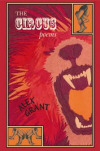The Circus Poems
The Circus Poems by Alex Grant defied my expectations, becoming more than “just” a book about circus performers through contextualizing the circus in history and myth and leading the reader toward the idea of the circus as metaphor.
The Circus Poems by Alex Grant defied my expectations, becoming more than “just” a book about circus performers through contextualizing the circus in history and myth and leading the reader toward the idea of the circus as metaphor.
The cover art by Sherill Ann Gross is vibrant and intriguing, and the book was beautifully designed by Leslie Rindoks, with illustrations of circus performers and a roaring lion. Each prose poem is titled after a circus performer, like “The Ringmaster” or “The Barker.” The majority of the poems are brief prose-poems, sparse and centered on the page. The poems are lush with description – in “The Human Cannonball” the character “hears the muffled voices, clanging metal, the soft liquid rumble sluicing behind, fire-gush and cordite thick in his mouth.” Grant fits each poem to the character, here allowing the poem to gain momentum, just as the human cannonball would, physically, gain momentum. “The Clown” was my favorite of the prose poems; it was not what you would expect from a poem about a clown, focusing obsessively, on the idea that “things are always collapsing” – “the moon disintegrates,” “it all turns / to dust eventually,” and, finally, it ends with “collapsing, always collapsing.”
“The Road to Archangel” is the first poem in the book that is not a prose poem. It takes the book from being about circus performers in general, as personas, to placing it in a distinct history and place – “Three days from Murmansk, two years since / the Czarina faced the firing squad – and comrade Lenin / spends his winters with the generals in Gremyachinsk.” The second departure from the prose poem style is “Marc Chagall’s Lament,” a poem written from Chagall’s perspective, detailing the monotonies and trials of his daily life: “Every morning is the same” – and again pulling the reader to Russia, as Chagall is begged “to leave Moscow to the proles and the Reds.”
Spirituality and the sense of a “hole” or absence in one’s life is seen first in the poem “The Road to Archangel” where the speaker’s brother pays for “the counsel of his Zen Master” who describes life as “coming up for air in an infinite ocean / and finding your head inside the only ring that floats,” successfully merging the idea of the circus (circus rings) with the absence, the emptiness in his life. The idea is revisited in “Cathedrals,” opened with a prose poem introduction on the opposing page, that describes “cardinals of the flooded church,” and later muses over the Native American legend of the dream-catcher, with its “hole in the center [that] lets the bad fly through / Every life should have such a hole.” “The Turnstile of Years” speaks of “a hole opening like a mountainside, pouring broken rocks into crevices / he never knew existed.” Other poems that touch on spirituality and the church are “The God Chaac Brings Lightning,” “Oden Hunts the Souls of the Dead,” and the similes “like churchbells in a foreign country” in the poem “The Juggler” and “the foundries clang like churchyards” in “The Knife-Thrower’s Assistant.” Grant subtly nudges the reader toward the idea of the circus as the church, the performers as mythic as gods.
While the prose poems provide interesting profiles of the circus performers, delving into the performers, the stereotypes, the idea of being defined, even named, by what you do, it was the free verse poems interrupting the steady onslaught of prose poems that truly contextualized and grounded the book. The result is an immersive, never heavy-handed, experience in the circus as a metaphor for human existence.





